Zatar or Za'atar, I love it! Until recently I was buying it from a company that specializes in spices. Recently it dawned on me that zatar is a spice blend, therefore I could probably create my own blend and you can too!

After all, I had already dabbled in and succeeded in making chili powder, curry, and garam masala, so why not zatar? A personalized spice blends make a great hostess gift plus, you can customize it to your family's palate. It's great fun. I recently made a batch of zatar and took it to some foodie co-workers; they were very excited.
Once you taste the difference between store-bought za'atar and homemade, you won't go back. That goes for most dried spices. Pre-ground spices don't have a great shelf-life despite what grocers want you to think, especially for herbs like dried parsley and cilantro. It's best to make dried herbs and spices on your own for guaranteed freshness and quality.
So what exactly is zatar? It is the generic name used to refer to a blend of spices popular in the Middle Eastern and Levantine cuisine. In fact, this spice blend is integral to Middle Eastern cuisine. Similar to salt, za'atar has its own way of enhancing the flavors of food it's sprinkled upon. Also like salt, there are very few dishes that would taste bad with za'atar on top. It's a perfect spice too since it couples so many different flavor profiles. Earthy, tangy, a touch sweet, and definitely aromatic, your homemade za'atar blend will not disappoint.
There are a couple of different types of zatar that I am familiar with. For the recipe I am sharing with you today, the main ingredient is sumac, the tangy, tart red powder from the dried berries of the sumac bush which is cultivated in southern Italy, the Mediterranean and the Middle East.
Sumac is a key ingredient in kebabs, fish, chicken and lamb. It can also be used to accent fish or vegetables dishes. Just sprinkle some on just before serving. Other ingredients in zatar are: thyme, oregano, and sesame seeds.

How do I use Za'atar?
- When I make chicken shawarma I like to sprinkle some za'atar on the fresh tomato and parsley before I wrap in a pita.
- Za'atar is also great on toasted pita, which we get at a local Middle Eastern market. We bake the pita until it is crispy, remove it from the oven and brush it with a bit of olive oil, then sprinkle on the za'atar. Yum, it is so tasty, and makes a great appetizer.
- Vegetables: I love sprinkling za'atar on my roasted eggplant. Cut your eggplant in half, drizzle some olive oil on the sliced side and sprinkle with salt. When you're done roasting, sprinkle your za'atar blend onto your eggplant.
- Make a dipping sauce! Add 3-4 tablespoon extra virgin olive oil to a small bowl along with 1-2 tablespoon of za'atar. Dip in some crusty bread or pita as an appetizer. You will love this!
- Hummus: Add as a topping to your hummus. When I make hummus I have to drizzle a little olive oil over the top and then add some za'atar. So good!
- Baba ganoush: I love baba ganoush, the zesty eggplant dip. It's even better with homemade za'atar sprinkled on top. Quintessentially Middle Eastern!
- Salads: Add some to your fresh salad greens for an added depth of flavor. You need to try this on your next salad!
- Snacks: Take your next batch of popcorn to another level! Add 1 tablespoon to your fresh popped corn and toss in a bowl to combine. Simple and delicious!
A little Za'atar History
As I previously mentioned, za'atar is a cherished herb blend across the Middle East that has really surged in popularity over the past few years. Food trends centering Middle Eastern cuisine came, and za'atar decided it was here to stay.
According to this article all about za'tar, it's hard to trace za'atar's history to a tee, but we know that it originated in the Middle East and has existed since biblical times, perhaps even Ancient Egyptian times. Za'atar is referred to multiple times in the bible as "ezov", and in Hebrew, hyssop. The writer mentions that some Israeli grocers even sell za'atar today under the title "holy hyssop", referring directly to its Biblical roots.
It's important to note that za'atar, while it has a set of core ingredients, can vary slightly depending on where you are in the Middle East. Some add ingredients such as cumin, coriander, fennel, caraway seeds, and marjoram to add a little twist.
A Little Sumac History
Remember that herb I mentioned to you before sumac? I want to dive into the history of it to give you a better idea of its importance in Middle Eastern and Mediterranean cuisine. Sumac is likened to lemon for its sourness and tang, so if you're really in a pinch, you might be able to get away with substitute lemon juice or lemon zest with some salt in place of sumac. The word sumac comes from the Arabic 'sumaq' which literally means dark red. Its use has been around since antiquity. The Romans used sumac in place of vinegar, and it was also used by the Greeks for similar culinary purposes. In Europe for example, sumac was used to impart a tangy taste on food until the Arabs introduced citrus fruits. In some countries sumac is widely used in folk medicine.
In some countries sumac is widely used in folk medicine, primarily in the Middle East and in South Asia. Sumac berries have diuretic properties, which is great for any digestive problems. Some say sumac is useful for reducing fever. In some parts of the Middle East, folks make a sour sumac beverage to relieve stomach pains and aches. I love thinking about the holistic purposes of food and herbs. It's humbling to think of our ancestral roots and how they fared without modern medicine!
Back in the 12th century, the Spanish Jewish philosopher Maimonides prescribed it to his patients for various ailments. Some recent research shows that oregano and thyme, key ingredients in zatar, have antioxidant properties. The ancients might have been onto something. So, as you can see, zatar is an awesome, flavorful, rich spice that can be used to season just about anything. Enjoy, and feel free to improvise by adding your personal touch.
If you like the exotic flavors of Middle Eastern food here are some of my favorites you can bookmark for later or pin them on Pinterest.
Middle Eastern lentil soup is a simple soup that has lots of rich flavors and little lemon juice.
Lamb stew infused with rose water, dried apricots, cherries and almonds has a really nice combination of sweet and savory flavors in a rich broth.
A salad to try would be a traditional Middle Eastern style tabouleh or tabbouleh that consists of lots of parsley along with bulgur wheat, mint, tomato and onions. You will love the bright flavors in this dish!
Your meal Middle Eastern dinner would not be complete without a dessert of these pistachio rose water shortbread cookies. These are so easy to make and have such a nice floral note.
Chicken shawarma is a dish you can make on the grill or pan sear with small pieces of chicken, a tasty spice bend and then wrap in a pita with a tomato, onions and top with a yogurt sauce. If you like baking you can try these Lebanese cheese fatayer which are a dough filled cheese, parsley and other spices.
📖 Recipe
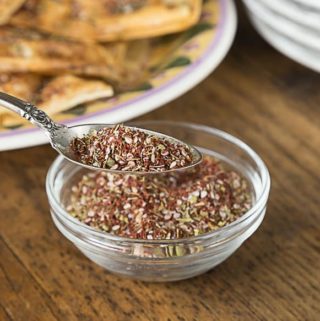
Easy DIY Za'atar
Ingredients
- 1 ½ tablespoon sumac
- 1 tablespoon thyme
- 1 tablespoon oregano
- 1 tablespoon sesame seeds
- 1 teaspoon Kosher salt
- ⅛ teaspoon nutmeg
Instructions
- Place the sesame seeds in a pan and turn the heat to medium and quickly toast. Remove them from the pan when they turn golden brown.
- Place the ingredients in a mortar and gently crush together.
- Place all ingredients in a jar and shake.
- Store in your pantry sealed for up to 6 months.

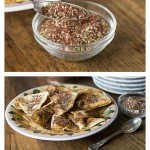
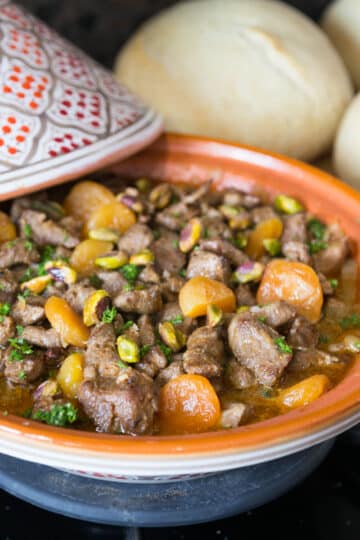
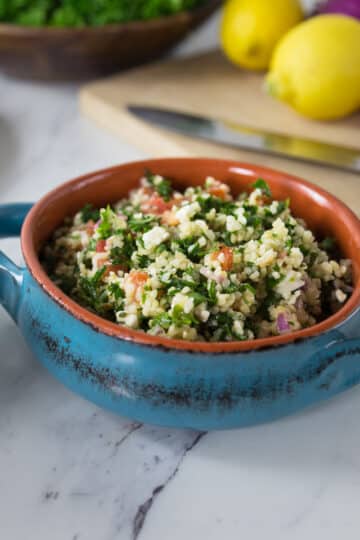
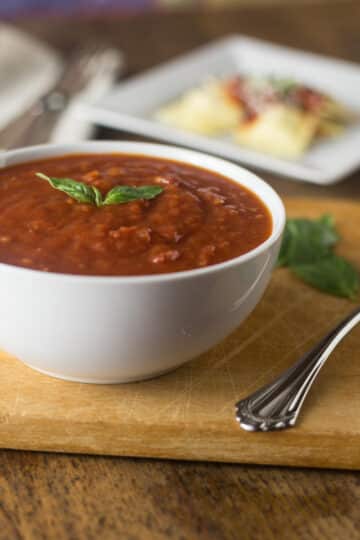

Denise Wright says
I cannot wait to make this. I thought I had a few jars of this and realized just a week or so ago that I have a lot of sumac not zaatar. My dad you used to pour a little olive oil on a plate and sprinkle the zaatar over the oil. Then he'd dip his pita bread in it and eat. Yum, yum, yum. I'm so excited about this recipe!
Analida says
Denise, it is so yummy in olive oil with pita to dip. We do that at home 🙂 I just made a batch the other day and gave some to some of my co-workers. Let me know how your zatar turns out.
Caroline says
I love zatar and you're right there's really no reason not to make it yourself. I must give it a try soon!
Analida says
Caroline, give it a try. It is so easy!!!
Kristen @ A Mind Full Mom says
I want to try that pita with Zatar--it is calling to me. Great recipe to have on hand.
Analida says
Hi Kristen! Yes, it is a great recipe to have close by, and so easy.
Joy @ Joy Love Food says
I've been wanting to make my own spice blends, this sounds wonderful and is such a great gift idea!
Analida says
Hi Joy! I love making my own spice blends. It's very easy. I just gifted some chili powder and some zatar to some of the girls on my floor, they were very happy.
Sarah says
This spice blend looks and sounds amazing!
Analida says
Thanks Sarah! It's really flavorful, and the best part: you can make it at home!!!
Adriana Garcia says
Saludos Analida, amo esta mezcla de especias!! Una amiga cuyos padres son árabes me ha regalado un frasquito y soy feliz! lo mezclo con aceite de oliva se lo agrego al casabe tostado, una delicia.
Analida says
Que bien Adriana! El zatar es delicioso y la mezcla es super facil de hacer. Si, con aceite de oliva y pan de pita es fabuloso.
laura@motherwouldknow says
I love za'atar and got some from a middle eastern restuarant where the chef was kind enough to give me a small container-full. I had been thinking about making my own, but never got around to figuring out which spices to use and the proportions. Now you've given me the key to making my own. Thanks!
Analida says
Hi Laura, it is so easy to make z'atar. My Middle Eastern friend told me that there are two kinds of z'atar: the kind on my blog and a green zatar which is made with oregano, parsley, thyme, sesame seeds and salt. Let me know how it turns out.
Banki says
Analida I admire your motivation towards creating your own blend. It gives room for more creative results. Also, I must say, you have an interesting blog.
Analida says
This is a great spice blend to sprinkle on hummus or add to some olive oil for a dipping sauce with pita.